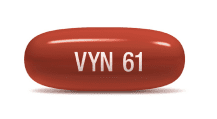Tafamidis Disease Interactions
There are 2 disease interactions with tafamidis.
Tafamidis (applies to tafamidis) hypothyroidism
Moderate Potential Hazard, Moderate plausibility.
Tafamidis binds to transthyretin (TTR) at the thyroxine binding sites. The use of tafamidis may decrease serum concentrations of total thyroxine, without an accompanying change in thyroid stimulating hormone (TSH). The reduction in total thyroxine values is probably the result of reduced thyroxine binding to or displacement from transthyretin due to the high binding affinity of tafamidis to the TTR thyroxine receptor. No corresponding clinical findings consistent with hypothyroidism have been observed. Exercise care when using this agent in patients with hypothyroidism.
References (1)
- (2019) "Product Information. Vyndaqel (tafamidis)." Pfizer U.S. Pharmaceuticals Group
Tafamidis (applies to tafamidis) liver disease
Moderate Potential Hazard, Moderate plausibility.
The use of tafamidis in patients with moderate hepatic impairment (Child-Pugh Score of 7 to 9) demonstrated decreased systemic exposure (approximately 40%) and increased clearance (approximately 68%) when compared to healthy subjects. No clinically significant differences in the pharmacokinetics of tafamidis were observed in patients with mild hepatic impairment (Child Pugh Score of 5 to 6). Use caution when using this agent in patients with severe hepatic impairment as its effect is unknown.
References (1)
- (2019) "Product Information. Vyndaqel (tafamidis)." Pfizer U.S. Pharmaceuticals Group
Switch to consumer interaction data
Tafamidis drug interactions
There are 32 drug interactions with tafamidis.
More about tafamidis
- tafamidis consumer information
- Check interactions
- Compare alternatives
- Reviews (18)
- Side effects
- Dosage information
- During pregnancy
- Drug class: transthyretin stabilizers
- En español
Related treatment guides
Drug Interaction Classification
| Highly clinically significant. Avoid combinations; the risk of the interaction outweighs the benefit. | |
| Moderately clinically significant. Usually avoid combinations; use it only under special circumstances. | |
| Minimally clinically significant. Minimize risk; assess risk and consider an alternative drug, take steps to circumvent the interaction risk and/or institute a monitoring plan. | |
| No interaction information available. |
See also:
Further information
Always consult your healthcare provider to ensure the information displayed on this page applies to your personal circumstances.


